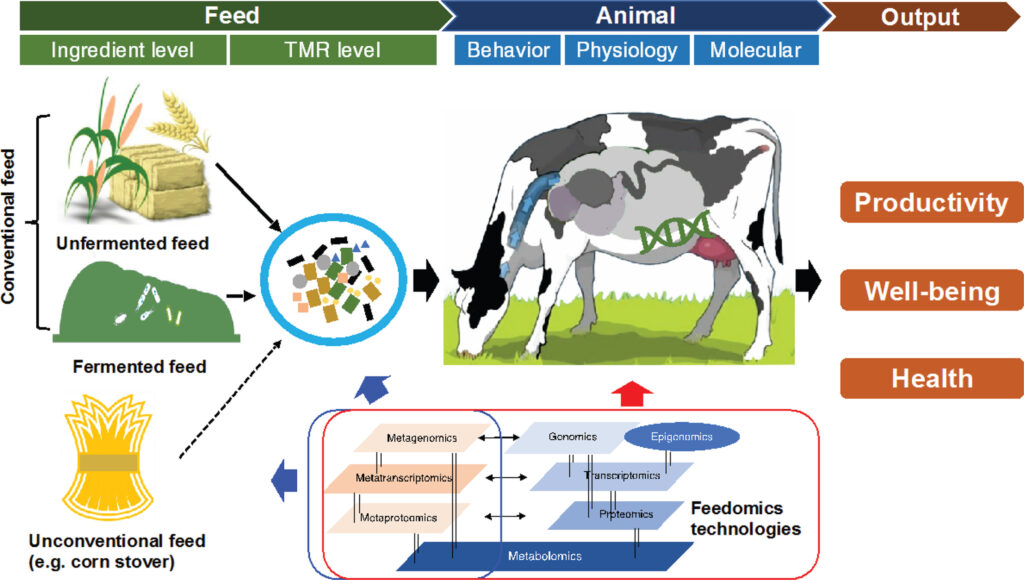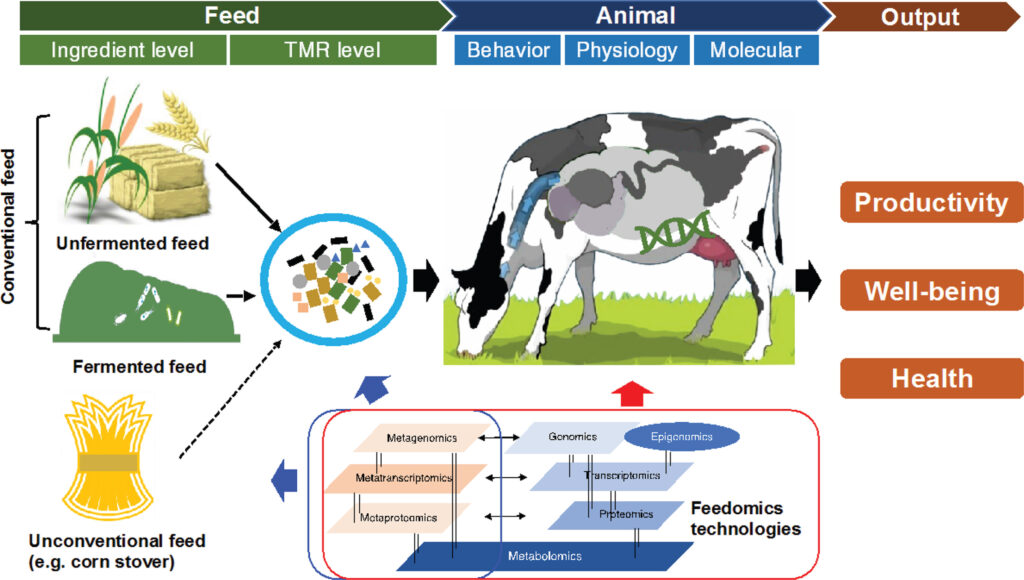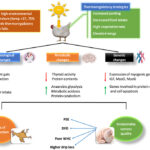

1. Introduction to Ruminant Nutrition
Ruminants (cattle, buffalo, sheep, goats) possess a unique four-compartment stomach that allows them to utilize fibrous plant material through microbial fermentation. Each life stage of a ruminant has specific nutritional requirements that must be met to optimize:
- Growth
- Reproductive performance
- Milk or meat production
- Overall health and disease resistance
A well-designed nutrition program tailored to each phase supports long-term animal productivity and economic returns.
2. Calf Nutrition
A. Importance
Early-life nutrition is critical for survival, immunity, and future productivity. Poor calf nutrition leads to stunted growth, delayed maturity, and reduced milk/meat yields.
B. Key Nutritional Phases
i. Colostrum Feeding (0–3 Days)
- First milk after birth, rich in immunoglobulins (IgG).
- Feed within 2 hours of birth (10% of body weight/day).
- Provides passive immunity and jump-starts gut function.
ii. Milk or Milk Replacer Feeding (0–8 Weeks)
- Whole milk or high-quality milk replacer (20–24% CP, 15–20% fat).
- Feed 10% of body weight daily in divided doses.
- Maintain hygiene to prevent diarrhea (scours).
iii. Introduction of Calf Starter (From 1 Week)
- Calf starter should be high in energy and protein (18–20% CP).
- Promotes rumen development via volatile fatty acids (VFAs).
- Offer fresh water and starter ad libitum.
iv. Weaning (6–8 Weeks)
- Wean when calf consumes 1–1.5 kg starter/day consistently.
- Transition gradually to reduce stress.
3. Heifer Nutrition
A. Growth Phase Nutrition (2 Months to 24 Months)
Heifers need balanced energy and protein for:
- Optimal growth
- Reaching breeding weight at ~15 months
- Avoiding obesity or stunted growth
B. Nutritional Targets
- Aim for average daily gain (ADG) of 500–700 grams in dairy heifers.
- Body weight should be 60–65% of mature weight at breeding.
C. Diet Components
- Forages (60–70%): Good quality hay, silage, pasture.
- Concentrates (30–40%): Protein meals (soybean/cottonseed), cereals.
- Minerals and Vitamins: Adequate calcium, phosphorus, vitamins A, D, E.
D. Avoid Overfeeding Energy
- Excessive fat deposition in prepubertal heifers reduces mammary gland development and future milk yield.
4. Dairy Nutrition
A. Objectives
- Maintain high milk yield and quality.
- Ensure good body condition.
- Support reproduction and health.
B. Key Nutritional Phases
i. Transition Period (3 Weeks Pre- to 3 Weeks Post-Calving)
- Prepare cow for calving and lactation.
- Prevent metabolic disorders like milk fever, ketosis, fatty liver.
- Provide:
- Controlled energy intake.
- Higher rumen undegradable protein (RUP).
- Anionic salts to reduce calcium imbalance.
ii. Early Lactation (0–70 Days Post-Calving)
- Peak milk production; feed intake lags behind.
- Focus on high-energy dense diets.
- Use bypass fat, yeast cultures, and rumen-protected amino acids.
iii. Mid to Late Lactation
- Energy balance improves.
- Maintain milk yield with balanced forages and concentrates.
- Monitor body condition score (BCS): aim for 3–3.5.
iv. Dry Period (60 Days Before Calving)
- Allow udder tissue regeneration.
- Feed low-energy, high-fiber diets.
- Supply vitamins (A, E) and trace minerals (selenium, zinc) to improve immunity.
C. Nutritional Components in Dairy Feeding
- Crude Protein (CP): 16–18% for lactating cows.
- Energy (TDN): >65% in high producers.
- Fiber: Effective fiber from silage, hay for rumen health.
- Water: 3–5 liters per liter of milk produced.
- Minerals & Vitamins: Calcium, phosphorus, magnesium, trace elements.
5. Meat Animal Nutrition
A. Goals
- Achieve maximum growth rate and feed efficiency.
- Ensure lean muscle development with optimal fat deposition.
B. Beef Cattle Phases
i. Backgrounding/Stocker Phase (200–350 kg BW)
- Grazing or high-roughage diets.
- Target moderate ADG (0.5–0.8 kg/day).
- Use protein and energy supplementation if pasture is poor.
ii. Finishing/Feedlot Phase
- High-energy grain-based diets (corn, barley, etc.).
- Rapid weight gain (1.0–1.5 kg/day).
- Monitor for rumen acidosis—include buffers or ionophores.
C. Sheep and Goat Meat Nutrition
- Focus on forages + energy/protein supplements (molasses, grains, oilseed cakes).
- ADG of 100–250 grams/day in fattening programs.
- Use of complete pelleted rations can enhance uniform growth and efficiency.
D. Feed Additives in Meat Production
- Ionophores (monensin, lasalocid): Improve feed efficiency.
- Probiotics, yeast: Enhance digestion and health.
- Beta-agonists, enzymes: Used in some systems for muscle growth (regulated).
6. Common Nutritional Disorders and Their Prevention
| Disorder | Cause | Prevention |
|---|---|---|
| Bloat | Excess legumes, high carbs | Roughage in diet, anti-bloat agents |
| Acidosis | Sudden grain feeding | Gradual adaptation, buffers |
| Ketosis | Energy deficit in early lactation | High-energy rations, propylene glycol |
| Milk Fever | Low blood calcium at calving | DCAD diet, calcium supplementation |
| Urea toxicity | Overuse of urea in diet | Proper mixing, avoid overfeeding |
7. Conclusion
Ruminant nutrition is the foundation of productive and profitable livestock farming. Each stage—calf, heifer, dairy, and meat production—requires tailored nutritional strategies based on the animal’s physiological needs and production goals. Balanced feeding, quality forage, proper supplementation, and disease prevention contribute to optimal growth, reproduction, and yield in commercial livestock systems.




Preetam Raam
23-CUVAS-0334
DVM 4th
23-CUVAS-0337
DVM(4th semester)
23-cuvas-0320
Dvm 4 th semester
23-CUVAS-0295
DVM 4TH
Laiba Hafeez
Reg no: 23-cuvas-0298
DVM 4th semester
23-cuvas-0320
Dvm 4 th semester
23-cuvas-0321
23-cuvas-0314
23-cuvas-0320
Dvm 4 th semester
Reg# :23-CUVAS-0312
DVM 4TH
23-cuvas-0300
23 – Cuvas – 0307
M Suffian Haider
23-Cuvas-0319
Reg#:23-CUVAS-0312
DVM 4TH
23-cuvas-0320
Dvm 4 th semester
23-cuvas-0321
Waseem saleem
23-cuvas-0326
Abdullah Sharif 23-Cuvas-0332
Laiba Hafeez
Reg no : 23-cuvas-0298
23-CUVAS -0333
Dvm 4th
333
Dvm 4th